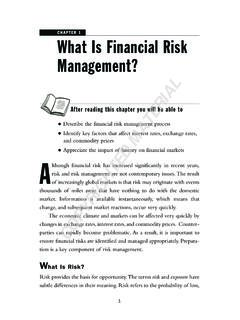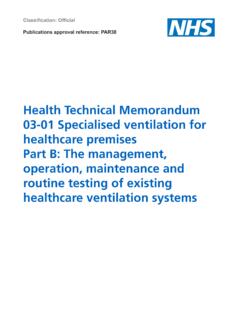Transcription of Best Practices for Solar Risk Management
1 Best Practices for Solar Risk Management A practical guide for financiers of Solar projects and portfolios 2017 Edition As part of its ongoing effort to codify industry best Practices , SEIA invited kWh Analytics and other members of the SEIA Solar energy Finance Advisory Council to jointly author this document. Additional support provided by the Department of energy 's Orange Button Program. 1. Introduction Tax equity and debt investment in Solar energy projects require complex due diligence and oversight by investors. Fortunately, the industry has matured greatly over the past decade, and industry stakeholders have developed highly effective risk Management techniques to improve the quality of project cash flows and reduce the risk of technological and credit-related risk factors. This analysis was written for bank risk managers, credit officers, and senior business leaders who recognize a wide range of potential risk factors pertaining to Solar investments and seek a systematic distillation of the industry's best Practices .
2 Since the risk Management function begins at origination, the audience also includes those within the sales or origination function at banks or within project finance groups at Solar companies. This report assumes that a reader has a basic competence in project finance and tax equity structures. This guide is designed to provide an authoritative perspective on Solar risk Management , as this document reflects experiences and learnings drawn from investors representing more than 50% of the market. In this report, we contrast risk Management , which is the responsibility of a financial investor, to asset Management , which is typically the domain of a Solar company to maintain the physical asset and the associated contractual arrangements. For our purposes, asset Management also includes the administration of an operations and maintenance program. Risk Management covers the investor's responsibility to satisfy the internal business and compliance requirements of senior business leaders, credit committees, internal and external auditors, and regulators.
3 The responsibility of the risk manager is to identify items that may lead to the financial deterioration of an investment, and proactively work to resolve these situations. Although much of the data is derived by the asset manager, a key role of the risk manager is to trust, but verify the results being presented to them. While Solar investments are sometimes called passive investments due to the nature of the structured vehicles, this is in practice a misnomer: Nearly every major investor in the renewable energy markets have staff dedicated to risk Management . Fortunately, there are a number of Practices and platforms in the market for financial investors to monitor, measure, and manage their risk. These best Practices are common between various segments of the Solar industry, ranging from distributed residential portfolios to utility-scale assets, and are the topic of this report. 2. Executive Summary of Best Practices Risk Measurement operational Risk One of the most fundamental risk Management Practices calls for ongoing monitoring of the actual electricity generation against projected electricity generation.
4 This is often a leading indicator of cash flow risk to an investor and acts as an early warning detection system. It's also important to separate underlying failures from short-term temporal impacts due to weather. Investors need to know if the system is working to an acceptable standard (often 90-95% of original projections), and if not, ensure that a plan is in place to remedy the situation or impair the asset. Regulatory and Counterparty Risk Unfortunately, nearly every large portfolio to date has seen the insolvency of a key vendor or sponsor. In this context, it is important for investors to know their exposure and any potential liabilities that may exist. Reviewing investment allocations and historic operating history may inform a warranty claim, a spare parts strategy, or a modification to O&M Practices . Offtaker Risk Measuring and normalizing delinquency and default metrics allow investors to rely upon historic performance to manage their risk and inform new investment opportunities.
5 For distributed portfolios, it is critical to define a materiality threshold of non-payment beyond which an investor would define the individual asset to be non-performing. Repayment Risk Ensuring that cash flows meet an investment vehicle's obligations, including loan payments and tax equity's preferred return (after expenses and taxes have been paid), is a core requirement for any asset-backed investment vehicle. Tracking cash flows and coverage ratios are an essential requirement to satisfy credit and compliance obligations in all investments, including Solar . Tax Risk Investors at all levels of the capital stack typically have some sort of exposure to tax credits . whether in the form of indemnities, insurance, cash sweeps, or extended flip dates. Tax equity investors typically track this exposure closely, and it is best practice for lenders to watch it closely as well. Regular Reporting Compliance Management requires consistent communication with credit teams and senior Management , generally under a monthly-quarterly-annual review cadence: monthly production look-backs, quarterly portfolio summaries, and annual portfolio reviews.
6 These reports incorporate production results, cash Management tracking, exposure analysis, offtaker credit updates, and other pertinent information about the health of their portfolio. 3. Industry Standards and Benchmarks Use industry-standard protocols Industry trade groups have established generally accepted compliance Practices to further the growth of the industry. These include: The United States Department of energy 's Orange Button data standard; model contracts; installation and O&M best Practices ; and consumer protection best Practices . Origination Standards Risk Management starts at origination, and risk managers work with originations teams to define the data and reports that should be provided over the lifetime of the investment. API access should be negotiated into agreements at this stage to ensure automated access to ongoing asset performance data. The originations and risk Management teams should also agree on final project budgets.
7 Performance Benchmarking Industry comps can be effective when evaluating the quality of an investment. Large Solar developers use it to compare the health of projects within their own portfolios. An emerging trend is for investors to utilize industry data to benchmark their portfolios' operating health and payment performance against anonymized, aggregated data sets compiling data from other operating portfolios. Component Benchmarking Risk managers can identify latent risks that may exist within portfolios by reviewing industry benchmarking data on equipment underperformance or regional performance trends. Compliant Infrastructure Asset-level system of record Banks need a system of record. However, Solar transactions typically don't readily conform to pre-existing system of record formats, either due to the structure of the deals to support tax motivated investors, or due to its dual nature as both an energy and financial asset. While a few investors have overhauled internal databases to manage their fleet, most are relying on risk Management software designed specifically to satisfy the particulars of the renewable energy industry.
8 Independent verification Third-party validation of reported results, run through data quality tests, can unearth surprising conclusions about the health of distributed Solar fleets. Independent experts can provide an element of compliance support to ensure the data being used to manage risk is reliable for decision-making. 4. Risk Management Checklist Risk Measurement Industry Standards and Compliance Benchmarks 1. operational Risk 7. Industry Standards 11. System of Record 2. Regulatory and 8. Origination Standards 12. Independent Counterparty Risk 9. Performance Benchmarking Verification 3. Offtaker Credit Risk 10. Component Benchmarking 4. Repayment Risk 5. Tax Risk 6. Regular Reporting 1. Tracking of Performance Index Tracking of Weather-Adjusted Performance Index 2. Tracking Allocations Vendors Geographies Utilities Offtaker Credit Quality Service Providers Sponsors 3. Tracking Delinquencies and Defaults Standardized Definitions 4. Tracking Cash Flows Tracking of Coverage Ratios Standardized Labeling of Transactions in Ledger of Record 5.
9 Tax Risk Tracking 6. Risk Reporting 7. Industry Standard Protocols Orange Button Model Contracts Installation and O&M Best Practices Consumer Protection Best Practices 8. Negotiated Data Sets during Origination API Access for Monitoring Platforms Agreement on Project Budget 9. Use of Relative Metrics for Industry Context 10. Component Benchmarking 11. Use of System of Record Asset-Level Tracking Adequate Security Controls 12. Independent Data Verification 5. Section 1: Measurement is the first step to Managing Risk Arguably the most important role of a risk Management professional is to measure and communicate risk factors to others within their organization. There are areas that risk managers are measuring to track the financial health of Solar investment portfolios: 1. operational Risk Projections of future energy production drive the financial model and, in most circumstances, the size of the investor's financial exposure. Performance Guarantees may be granted to an offtaker or an investor based on these projections, and production insurance policies are underwritten to these projections.
10 After an investment has been made, the actual energy production can be viewed as one of the most important indicators of risk to an investor. The ratio of the actual electricity generated to the initial projection is called its Production Index. Investors need to know if the system is working to an acceptable standard, which is often 90-95% of original projections, and if not, ensure that a plan is in place to remedy the situation. From a risk Management standpoint, the Performance Index is important for the following reasons: Under-production presents cash flow risk in situations where there is a Power Purchase Agreement (PPA) in place with the offtaker, since the cash flows are a direct function of electricity production. However, even when the offtaker has signed a lease or a loan, production guarantees may still be in place that must be paid out if performance dips below certain thresholds. In situations where a direct lease or loan is provided to the energy consumer, the production is an important driver of credit risk, since it is commonly believed that end users are less likely to make timely lease or loan payments if the asset is malfunctioning or materially underperforming.













